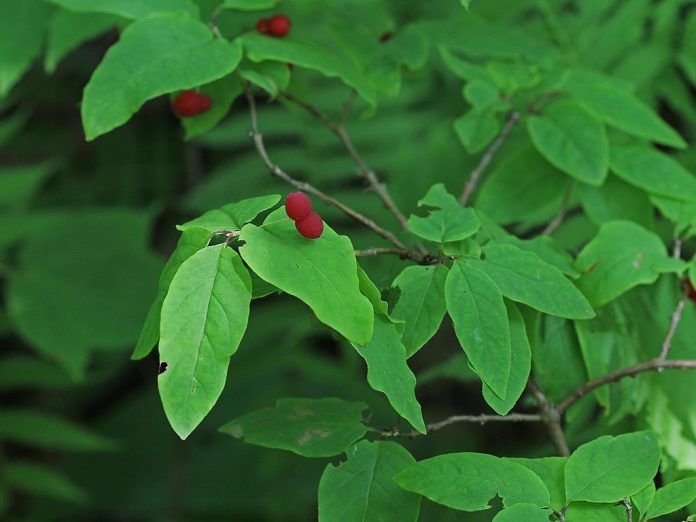
Featured Photo by Rob Routledge / CC BY 3.0
A field guide on how to identify and propagate Fly Honeysuckle (Lonicera canadensis), a hardy shrub that is native to the boreal forest.
How to Identify Fly Honeysuckle (Lonicera canadensis)
Leaves
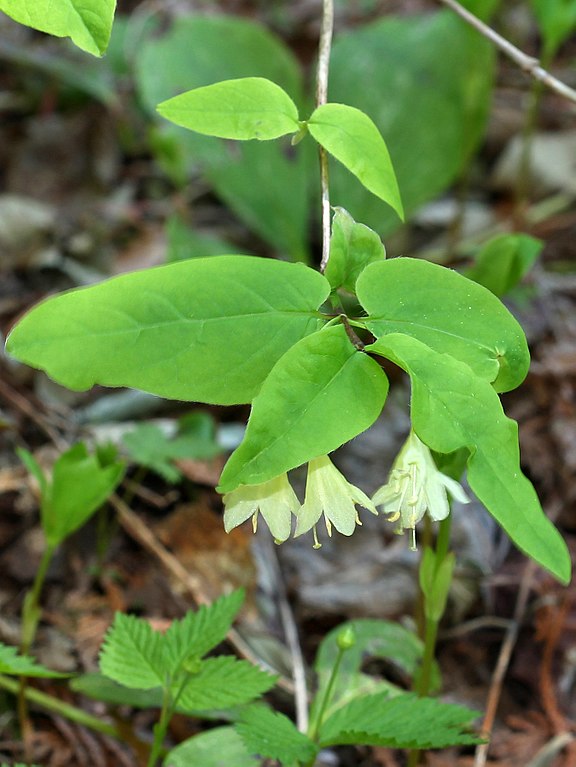
Fly honeysuckle leaves are ovate, oblong, or cordate-shaped, with entire margins (smooth), and covered in tiny little hairs. They grow on the stems in opposite arrangements.
Fruits
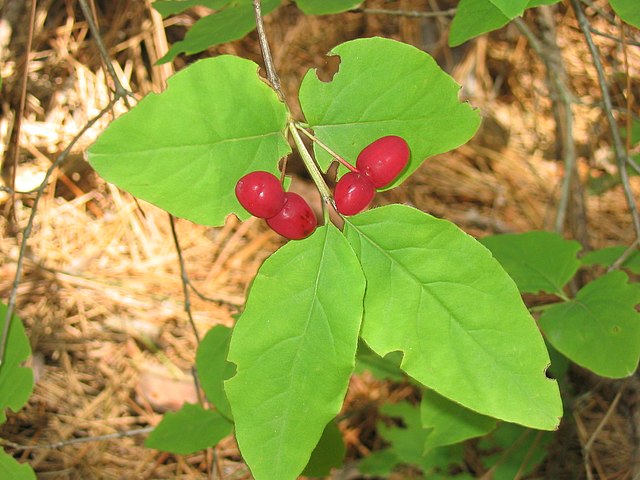
Fly honeysuckle fruits are small, round, and grow in pairs. They each measure about 1/4 inch in diameter and have smooth, shiny skin that can be either red or yellow in color.
Flowers
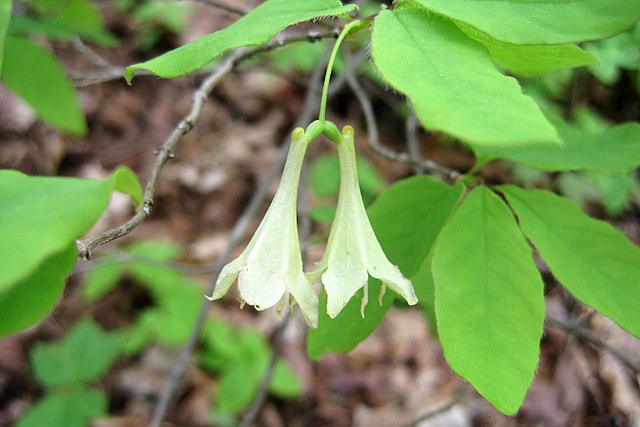
The flowers are small, tubular-shaped, and arranged in pairs that grow from the leaf axils.
They are typically a pale yellow color with sometimes a purple tinge. Each flower has 5 flaring triangular lobes.
Flowering Season
Fly honeysuckle has a relatively short blooming season, with flowers appearing in late spring or early summer.
Habitat
You can typically find it growing in moist to wet habitats such as swamps, bogs, and along streams and rivers.
Some other understory plants & trees that associate with fly honeysuckle are:
- False Solomon’s Seal (Maianthemum racemosum)
- Balsam Fir (Abies balsamea)
- Yellow Birch (Betula alleghaniensis)
Wildlife Value
There are a variety of birds, insects, and mammals that may benefit from Lonicera canadensis (American fly honeysuckle):
Birds:
- Ruby-throated Hummingbirds
- Cedar Waxwings
- Eastern Bluebirds
- Baltimore Orioles
- American Goldfinches
- Butterflies (such as the Spicebush Swallowtail and the Red-Spotted Purple)
- Bees (such as the Rusty Patched Bumblebee)
- Moths (such as the Hummingbird Clearwing)
How to Propagate Fly Honeysuckle (Lonicera canadensis)

Hardiness Zone: 3-7

Soil Type: Well-drained clay, loam, sand.

Water: Normal to High.

Exposure: Full Sun to Partial Shade.
You can propagate fly honeysuckle with two effective methods:
- Stem Cuttings: It provides established shrubs faster, but is tricky.
- By Seed: It can be done at a large scale quickly with a good chance of success.
How to Propagate Fly Honeysuckle (Lonicera canadensis) by Seed
If you want to propagate Fly Honeysuckle, a great way is to start from seed. You can try to find some wild seeds yourself or buy some online if you can manage to find a website.
Now if you successfully identified a wild fly honeysuckle shrub, the next step is to harvest the seeds.
Here are some tips on how to do it:
How to Harvest Seeds
Timing: Wait until the fruit is fully ripe, which usually happens from mid to late summer through fall.

Extracting & Drying: Remove the pulp and extract the seeds, you can do that by mashing them on a screen. Next, dry the seeds and store them at room temperature until stratification.
Stratification: Fly honeysuckle needs to undergo a period of cold stratification to break its dormancy. Store the seeds in a plastic bag filled with moist sand in the refrigerator for 60 days.
Sowing
Scarification: Soak the seeds for 12-24 hours prior to sowing.
Starting Soil: Sift some garden soil mix to remove the large chunks & wood chips.
Sowing: Sow the seeds in a seed tray or individual pots in early spring, at a depth of 1/16 inch. Cover lightly with soil and water regularly.
Germination: Fly honeysuckle seeds take several weeks to germinate.
How to Propagate Fly Honeysuckle (Lonicera canadensis) by Cuttings
The best method to propagate fly honeysuckle is to take semi-hardwood cuttings. That’s the current year’s growth that’s hardened enough to harvest without much worry of wilting back.
Timing: A rule of thumb with most plants is to wait at least 6 weeks after the first leaves of spring to harvest from them. Harvest them when the plant is still actively growing, and early in the morning.

Taking the Cuttings: Take a 6-8 inch cutting from a healthy, fly honeysuckle plant. Make sure the cutting is taken from semi-hardened stems.
Prepare the Cuttings: Remove the lower leaves from the cutting and dip the end in a rooting hormone to encourage root growth.
Plant the Cuttings: Insert the cutting into a well-draining rooting medium, such as a mix of peat and perlite or coarse sand. Make sure the soil is moist but not waterlogged.
Provide Proper Care: Place the cuttings in a warm, bright location but out of direct sunlight. Mist the cuttings regularly to keep the leaves hydrated and the soil moist. After 4-6 weeks, the cuttings should have rooted.
Transplanting: Once the cuttings have rooted and started to grow new leaves, they can be transplanted into larger pots or directly into the ground. Make sure to add some slow-release fertilizing granules to promote healthy growth.
Fly honeysuckle (Lonicera canadensis) is a species of lonicera plants, and they all propagate in a similar way. If you have unanswered questions and would like a more in-depth guide, take a look at our parent article:
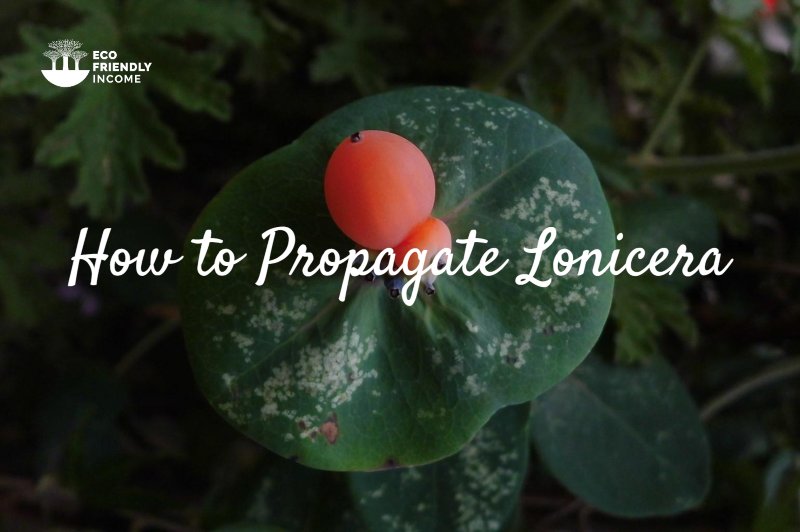
FAQ
A: I’m not sure, I haven’t tried, but many Lonicera berries are poisonous to some extent and should not be consumed.
A: Lonicera canadensis is a native, non-invasive species of honeysuckle that is easy to grow and maintain. It is also a valuable wildlife plant, providing food and habitat for birds and other animals.
